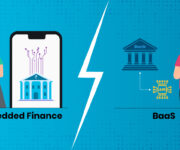While the COVID-19 pandemic has dramatically impacted the traditional banking system, it also has helped digital banking to gain rapid acceptance. Meanwhile, Indian Fintechs are flourishings and touching almost every banking value proposition.
With the government’s push towards digital initiatives, there’s no doubt that we will be witnessing more digital financial products in the future. However, we have already witnessed several examples of traditional and fintech collaborations leading to many success stories like- State Bank of India partnered with Uber providing vehicle finance for drivers, Snapdeal with Yes Bank providing instant refunds, etc.
Most of these collaborations are made only possible as a result of banks allowing access to their technology and data to be used by external parties. This is what is meant to be Banking-as-a-Service (BaaS).
What is Banking-as-a-Service?
BaaS is an end-to-end process that allows fintech and other third parties to connect with the bank systems directly via APIs to facilitate specific banking options – loans, cards, deposits, insurance, payments, etc. In the financial services sector, BaaS platforms have surfaced as a key component of open banking wherein banks provide more financial transparency for the account holders.
The tech-savvy legacy banks can fend off the encroaching threat of fintech by moving into the BaaS space for sharing their data and infrastructures. Within a few years, access to this kind of information will become common for native customers, so the banks that begin now will be ahead of the curve and likely to be rewarded with high demands.
How Does Banking-as-a-Service Work?
The BaaS process starts with a fintech or other third-party provider paying a fee to access the BaaS platform. Then the financial institutions acting as the BaaS provider opens their APIs to the third-party provider. Here it grants access to the systems and information needed for building new banking products or offer white label banking services.
In addition to getting ahead in open banking, institutions that launch their own BaaS platforms will also open up new revenue streams. The two main monetisation strategies for BaaS include charging clients a monthly fee for accessing the BaaS platform or charging a fixed price for each service used.
In simple words,
- Fintech company/ individual pays to use BaaS
- Bank/financial institution which is a BaaS platform opens its APIs
- Fintech company/individual builds innovative financial services using these APIs
Moving Forward with BaaS
While adopting the BaaS model, banks must take a personalised, in-depth look at their organisation’s strategy and future initiatives. Here we list down six crucial considerations that can facilitate successful BaaS adoption.
1. Identify Business Capabilities to Offer as a Service
In order to identify optimal business capabilities, banks need to first define their specific goal for providing BaaS, whether it enhances customer service, monetisation, and revenue growth. Based on the response the company can then develop a fitting strategy.
For instance, if the first-mover advantage is vital, banks will provision commoditised service capabilities for facilitating rapid industrialisation and ease of implementation. A large private bank in India had partnered with the fintech MatchMove, a Singapore-based company offering virtual card remittance services for tapping into the e-commerce and payments market.
2. Form Beneficial Partnerships and an Interactive Ecosystem
Despite the many BaaS benefits, adoption is still a question mark, as many banks are still unwilling to lose control of the customer. Banks face a conundrum, ie. If they don’t embrace BaaS, they lose out to competition from new technology entrants.
Banks need to ensure that the third-party partnership does not result in a fragmented customer experience. The partnership needs to be structured in a way so that APIs equally benefit the bank and fintech providers. For example, APIs provide Fintech with a broader market in which to sell their services, wherein banks benefit from the ability to cross-sell related products and services hosted elsewhere on the platforms in which they participate.
3. Consider New Pricing Models to Extract Greater Business Value
Banks will make APIs available to partners and developers creating solutions for end-user consumptions. Best-in-class monetisation practices indicate a hybrid model, in which APIs and services are individually tagged to the highest ROI method.
With this, end-users can pay transaction fees to use solutions and services, whereas the partners and banks can enter into a revenue-sharing agreement, such as pay-per-click advertisements. For instance, Nationwide in the UK has partnered with Apple Pay launching a digital wallet solution. This is built on a hybrid revenue-sharing agreement allowing users to store card information for the bank’s credit and debit cards, making contactless purchases.
4. Identify an Operating Model that Advances Business Objectives
Develop an efficient operating model that supports BaaS by constructing a dedicated channel that is actively managed and structured to align business with IT. This can be made possible through the creation of an enterprise center of excellence that mainly focuses on architecture, engineering, governance, and security management.
The lines of business will be responsible for deciding on the service catalog and associated requirements to be provisioned using BaaS. This ensures standardisation and enables effective organisational control for the service design.
The Road Ahead for BaaS in India
Technological advancements are accelerating the trend towards IT consumerisation, commoditised banking services, and higher consumer expectations for convenience and accessibility. In the last few years, India has taken monumental steps in developing a strong foundation to embrace the wave of change in the financial services industry.
Now even many banks embrace a service-oriented and componentised architectural approach that results in a massive reengineering of traditional back-end processes. Furthermore, the advent of open banking will further catalyse componentisation, which in turn will result in increased inter-bank and fintech collaborations in the future.
With the increase of consumer needs, expectations, and technology-enabled capabilities, the impact of BaaS will only grow wider. In order to stay digitally relevant, preserve market share and retain an industry presence, most banks will need to fully embrace BaaS.
Softwares like Finezza can help financial players and lenders brush up their lending process in times to come. Not only does this offer a highly digitised way to access loan products for customers, but also streamlines loan decision-making and processing easier at the end of the lender. Contact us now to know more.




Leave a Reply